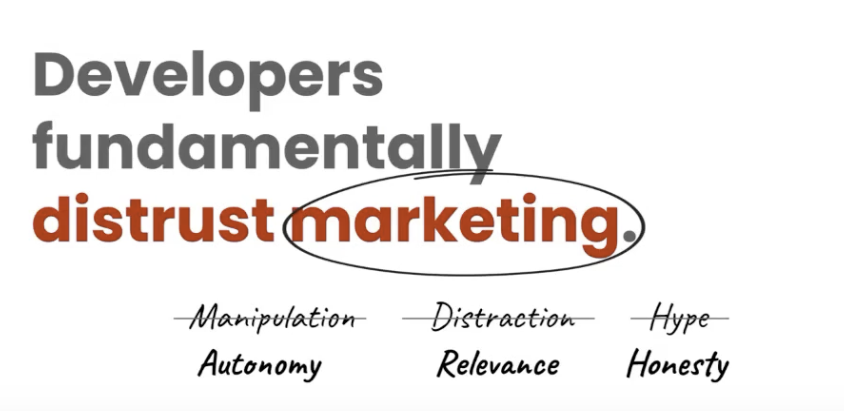Part 1 of the Dev Engagement Series: Developer Voice
Developer marketing falls apart fast when you get the voice wrong.
Most teams underestimate how quickly developers can sniff out nonsense.
You can spend months polishing a homepage, building an onboarding funnel, and lovingly crafting email sequences… but if the very first sentence reeks of hype, every subsequent effort is crawling uphill.
Developers don’t hate marketing.
They hate being marketed at.
And if your communication feels like it was written for a boardroom rather than someone who’s just trying to get a prototype running before lunch, you’ve already lost them.
This is why, when we run Discovery Calls at Stateshift, developer voice is almost always the first thing we diagnose. It sits underneath everything else. If your voice is misaligned — too corporate, too vague, too clever, too “let me show you our incredible AI-powered next-gen synergy layer” — nothing downstream performs the way it should.
This article kicks off a five-part series breaking down the core pillars of developer engagement:
- Developer Voice
- Developer Metrics
- Stickiness (Time to Value)
- Strategy vs Execution
- Sequencing
We’re starting with voice because, as daft as it sounds, getting this right often solves half the problems teams bring to us.
Let’s dig into the mechanics of how to communicate with developers in a way that earns trust, reduces friction, and actually drives adoption — the heart of effective developer marketing.
Why Developers Distrust Most Company Messaging
Developers are some of the most curious, collaborative humans you’ll meet… and also some of the most suspicious.
Why?
Because they’ve been burned — repeatedly.
They’ve been promised tools that would “revolutionize their workflow,” only to discover that the revolution requires signing up for yet another dashboard and configuring YAML files that look like ancient manuscripts.

I empathise with this more than most.
When I discovered Linux at 19, I was working in a bookshop and stumbled across a chapter describing how people all over the world were building software together. That spirit — clarity, collaboration, zero-fluff communication — shaped my entire career. Developers take ideas seriously; they don’t take nonsense seriously.
And over time, they’ve developed exceptionally strong filters for:
- hype
- corporate abstraction
- vague language
- anything requiring a credit card
- anything requiring a meeting
- anything “AI-powered” but suspiciously undefined
When clients ask during Blueprint Calls:
“Why isn’t our developer marketing landing?”
Nine out of ten times, the real answer is:
“Developers don’t trust how you’re showing up.”
Not what you’re building.
Not your strategy.
Not your roadmap.
Just how you talk about these things.
Let’s break down the biggest trust-breakers — the mistakes we see across hundreds of teams.
Trust-Breaker #1: Over-Polished Language That Says Very Little
Developers can detect vague, corporate language with the precision of a sniffer dog at Heathrow.
The moment your homepage says:
“The industry’s most innovative, enterprise-ready, AI-accelerated platform for digital transformation.”
…you’ve lost them.
Developers don’t want poetry.
They want clarity.
We had a client come in with a homepage filled with sweeping, glossy phrases. It sounded beautiful and communicated absolutely nothing.
Within two hours, we stripped away everything that wasn’t concrete.
They went from:
“Accelerating innovation at scale through unified AI orchestration.”
To:
“Keep the packages you trust. Fix the vulnerabilities you don’t.”
Simple.
Specific.
Honest.
Developer signups went up immediately.
Because clarity signals competence.
And competence builds trust faster than any adjective.
Trust-Breaker #2: Friction Disguised as “Onboarding”
Here’s a painful truth:
Most onboarding isn’t onboarding.
It’s a slow-motion exit.
If your first-time user journey requires:
- a credit card
- a phone number
- three identity checks
- a 10-step wizard
- installing half the internet
- and a sacrificial offering to the YAML gods
…developers vanish faster than biscuits in a British office kitchen.
Teams often tell us:
“We have a top-of-funnel problem.”
“We need more traffic.”
“We need more awareness.”
But the data rarely agrees.
Once we dig into dashboards during a Blueprint Call, the real pattern emerges:
Developers show up.
They just don’t stay.
Onboarding is where trust is either built or destroyed.
Superbase is a good example of doing this well:
- No credit card
- No ceremony
- No multi-page sign-up form
- You can deploy something meaningful in minutes
Meanwhile, some cloud providers require more proof of identity than a mortgage application before they’ll let you spin up a VM.
Here’s the rule:
If it takes longer to sign up than it does to evaluate your product, you’re in trouble.
Developer marketing isn’t about creating a theatrical entrance.
It’s about removing friction so developers can see value fast.
Trust-Breaker #3: Emails That Sound Like Marketing Emails
Most marketing emails written for developers read like they were designed by committee:
“Hi {FirstName}, we’re excited to announce an industry-leading breakthrough…”
Developers don’t want excitement.
They want information.
One client sent an email that simply read:
“New today: custom entity types and edge types. Here’s how to use them.”
Short.
Plain.
Actionable.
Engagement jumped by 3–4x.
The lesson isn’t “write shorter emails.”
It’s:
Write like you’re helping a developer ship something today — not like you’re trying to impress a VP of Marketing.
What Developers Actually Value in Your Communication
Across hundreds of engagements at GitHub, Ubuntu, XPRIZE, Okta, GitLab, Coda, Dragonfly, and more, the same five values show up repeatedly. They are the backbone of effective developer marketing.
Autonomy: Let Them Drive
Developers don’t want to be shepherded through funnels.
They are self-directed learners.
When teams remove forced flows in Acceleration Calls, activation begins to rise almost immediately.
Practicality: Show Real Workflows
Developers trust what they can verify:
- real commands
- real examples
- real configuration
- real failure modes
“Here’s how it works” will always outperform “Here’s why it’s transformative.”
Relevance: Speak Their Language
Developers live inside:
- docs
- examples
- terminals
- repos
- PRs
- chat threads
- issue trackers
They do not live inside marketing abstractions.
If your messaging requires translation, you’ve already lost momentum.
Honesty: Acknowledge Trade-offs
Developers already assume your product has limitations.
You gain trust by admitting what they already know.
Humanity: Show Your People
Developers trust humans, not brands.
A simple Loom from an engineer explaining a decision outperforms any cinematic “overview video.”
How to Write in Developer Voice Without Trying Too Hard
This is the practical version we teach in our frameworks and coaching — refined over 27 years of doing this work.
1. Speak Like You’re Talking to Another Senior Engineer
Not up. Not down. Across.
2. Say the Thing Simply
If it wouldn’t survive the “pub test,” rewrite it.
3. Use Real Examples (Code > Concepts)
Developers know the difference instantly.
4. Show the Trade-offs
This builds enormous credibility.
5. Keep the Hype Low, the Confidence Quiet
Developers reward grounded competence, not theatrics.
6. Respect Their Time
Shorter, clearer, more direct.
Good developer marketing is respectful developer communication.
Why Developer Voice Is the Foundation — Not a Layer
Teams often come into Blind Spot Reviews thinking they have:
- an onboarding issue
- a content issue
- a metrics issue
- a community issue
But the root problem is frequently voice.
If your voice is off, everything else becomes harder:
- funnel leaks
- community stagnates
- activation stays low
- engagement feels uphill
- metrics are noisy
Fixing voice fixes the system.
This is why developer voice is always one of the first things we diagnose in a Blueprint Call.
The Stateshift Approach
Our model is simple and systematic:
Discovery Calls
Understand how you currently communicate — and where trust is breaking.
Blueprint Calls
Identify target metrics, analyze gaps, and sequence the right work in the right order.
Acceleration Flywheel
Every two weeks during Acceleration Calls, we:
- Review data
- Form a hypothesis
- Implement
- Repeat
Voice sharpens.
Onboarding accelerates.
Engagement improves.
And the entire experience starts to feel aligned — like your product, your docs, and your communication finally sound like they belong to the same company. When teams fix voice, everything downstream becomes easier: cleaner demos, stronger content, fewer support tickets, more confident developers.
On-Demand Coaching
Async reviews of docs, landing pages, copy, and messaging.
This is where most teams find their biggest breakthroughs. Not in rewriting everything from scratch, but in tightening what already exists. A confusing sentence becomes clear. A misleading headline becomes useful. A 5-step Quickstart becomes a 2-step Quickstart. Developer trust is built in these small but meaningful corrections — the kind that compound week after week.
Blind Spot Review
A free session to identify the three biggest voice mismatches holding you back.
It’s often the simplest things: messaging written for executives instead of engineers, examples that don’t mirror real-world scenarios, or an onboarding message that unintentionally raises suspicion. These sessions help teams see what’s been in their blind spot for months — or years — and walk away with a practical plan to correct it.
What’s Next in the Dev Engagement Series
Part 2 — Metrics: How to Measure Developer Engagement Without Chasing Vanity Stats
This is where most teams go wrong.
But it’s also where developer marketing becomes measurable and predictable.
Before You Go: Download the Developer Voice Guide
If you want to tighten your developer marketing voice today, we put together a free PDF: the Stateshift Developer Voice Guide.
It covers the eight principles we use in every Blueprint Call, Acceleration Call, and On-Demand Coaching review:
- how to strip away hype
- how to speak in real examples
- how to write for senior engineers
- how to show trade-offs without losing confidence
- how to simplify without dumbing down
It’s practical, concise, and built for teams who want to speak to developers like practitioners — not marketers.
👉 Download the Developer Voice Guide:
And if you’d like a quick outside perspective, you can also book a Blind Spot Review — a short session where we walk through your messaging and pinpoint the trust gaps you probably can’t see from the inside. I’ll share the booking link so you can grab a spot.
FAQ: Developer Marketing & Developer Voice
Why is developer marketing so different from traditional marketing?
Because developers have unusually good nonsense detectors. They’re trained to evaluate claims, spot abstraction, and look for what’s actually happening under the hood. This is why Stateshift focuses so heavily on clarity and technical accuracy in developer marketing — those are the signals developers trust most.
What’s the biggest mistake teams make in developer marketing?
Trying to impress instead of trying to help. Over-polished language, vague value props, and “AI-powered” buzzphrases all create friction. In our work at Stateshift, we consistently see that developers respond to practical, example-driven communication — not slogans.
How can I make my onboarding more “developer friendly”?
Remove anything that feels like ceremony: credit cards, long forms, required demos, multi-step wizards, and over-engineered setup paths. Let developers drive. The goal is to get them to first value as quickly as possible — ideally in minutes.
How does Stateshift help with developer marketing?
We focus on systematic improvements — not one-off copy edits or brand statements. Through Discovery Calls, Blueprint Calls, Acceleration Calls, and On-Demand Coaching, we help you tighten the voice, reduce friction, and speak like a team who actually understands developers.
Want to see more….
In this video, I break down 3 brutally honest reasons why developers don’t trust your messaging—and how to fix it today. Whether you’re launching a dev tool, building a community, or trying to increase adoption, this is your reality check.





